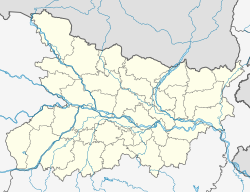Sukhpur
This article has multiple issues. Please help improve it or discuss these issues on the talk page. (Learn how and when to remove these messages)
|
Sukhpur | |
|---|---|
village | |
| Coordinates: 26°03′N 86°32′E / 26.050°N 86.533°E | |
| Country | |
| State | Bihar |
| District | Supaul |
| Languages | |
| • Official | Maithili, Hindi |
| Time zone | UTC+5:30 (IST) |
| PIN | 852130 |
| Telephone code | 06473 |
| Vehicle registration | BR-50 |
| Coastline | 0 kilometres (0 mi) |
| Nearest city | Supaul |
| Lok Sabha constituency | Supaul |
Sukhpur is a village located in the northern part of Bihar, within the Supaul district.[1] Geographically, it lies in the fertile plains of the Kosi River, known for its nutrient-rich alluvial soil. The region is agriculturally prosperous, and despite the flood-prone nature of the Kosi, the main habitation areas of Sukhpur have remained largely unaffected, except for occasional inundation in the outskirts.
The village is laid out in a well-planned, semi-clustered morphology, with distinct zones for residential and agricultural use. Sukhpur is bordered by several villages including Parsarma, Parsoni, Bero, Malhni, Balha, Solhni, Karanpur, and Nawhatta.
Climate
[edit]Sukhpur experiences a humid subtropical climate, with mild summers and cool winters, influenced by its proximity to the eastern Himalayas. The temperature can drop as low as 8°C during winter months. The village receives abundant monsoon rainfall (over 250 cm annually), primarily from May to September.
Agriculture and Economy
[edit]Agriculture is the primary occupation of the villagers. Thanks to the fertile soil and ample water supply, three cropping cycles are common annually. Major crops include:
- Cereals: Paddy, wheat, and corn
- Pulses: Moong (green gram)
- Horticulture: Mango and litchi, especially mango, play a pivotal role in the village’s economy
Notably, three major mango orchard zones—Lalbagh, Kalibagh, and Mamabagh—are significant contributors to local income. Sukhpur is regionally renowned for the variety and quality of its mangoes, often sold in local and district markets.
Education
[edit]Sukhpur serves as an educational hub for the surrounding villages, with a number of government and private schools. The village boasts a higher secondary school that attracts students from neighboring areas. Literacy rates are improving steadily, and there's a growing awareness of the importance of digital and vocational education.
Health and Amenities
[edit]The village is relatively well-developed in terms of amenities:
- A primary health center (PHC) serves the medical needs of residents.
- Presence of banks, marketplaces, and communication infrastructure.
- Sukhpur is well connected to the nearby towns of Supaul and Saharsa via road.
Religious and Cultural Life
[edit]Sukhpur is culturally vibrant and religiously significant in the region. It is home to:
- Tilheswar Sthan Temple, a revered Shiva temple that draws pilgrims from across the area.
- Devi Mandir (Maiyaa Ghar) in Bhadarpatti Tola, known for its strong local devotion.
- The annual Dussehra celebrations are especially famous and draw large crowds.
The village celebrates a blend of Hindu and Islamic festivals, reflecting its religiously plural society.
Demographics and Social Structure
[edit]Sukhpur has a diverse population predominantly practicing Hinduism and Islam. Hindu society here is segmented into several castes and Tolas (hamlets):
- Dayodhi (Royal Rajputana)
- Bhadarpatti (Yadav)
- Gauripur (Brahmin)
- Purabia Tola (Rajputs and Maithil Brahmins)
- Mushari (Dalit community)
While caste identities remain visible in social customs and settlement patterns, untouchability and caste discrimination have significantly declined.
Transport and Connectivity
[edit]Sukhpur is connected by pucca roads to Supaul and Saharsa, facilitating access to administrative services, markets, and healthcare. Buses and private vehicles connect the village with district headquarters and nearby blocks.
References
[edit]- ^ "Basic Population Figures of India, States, Districts, Sub-District and Village, 2011". censusindia.gov.in. Ministry of Home Affairs. 2011. Archived from the original on 11 July 2022. Retrieved 18 May 2025.


